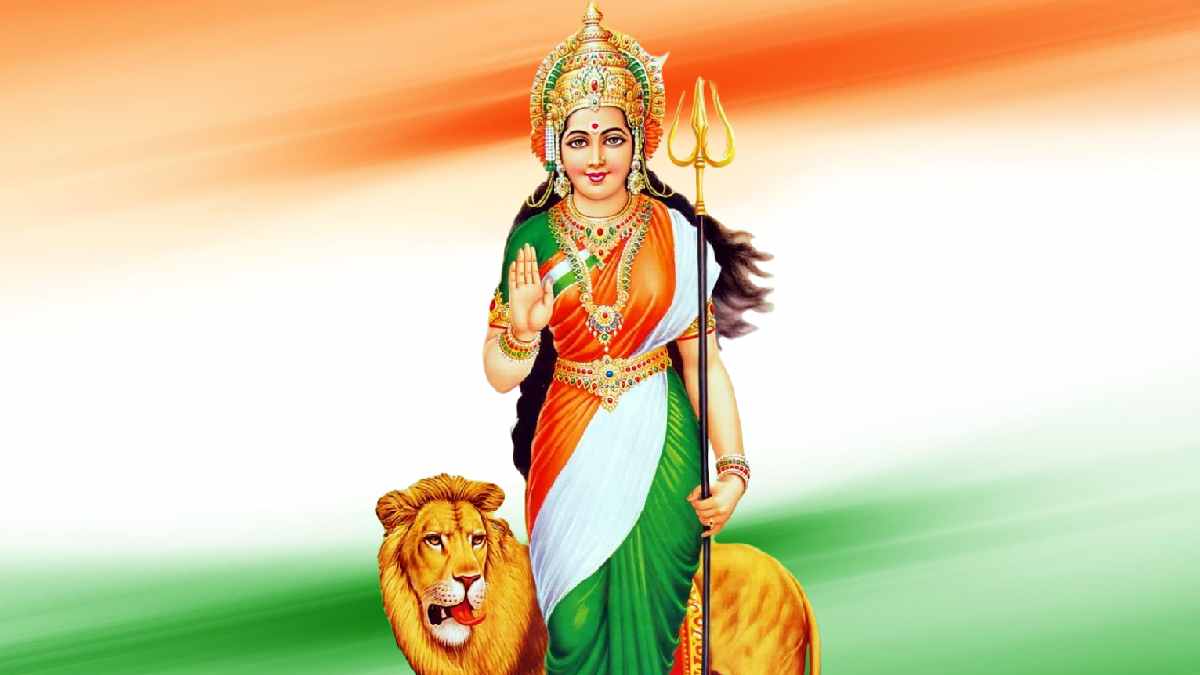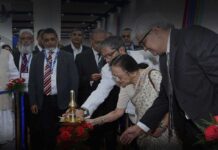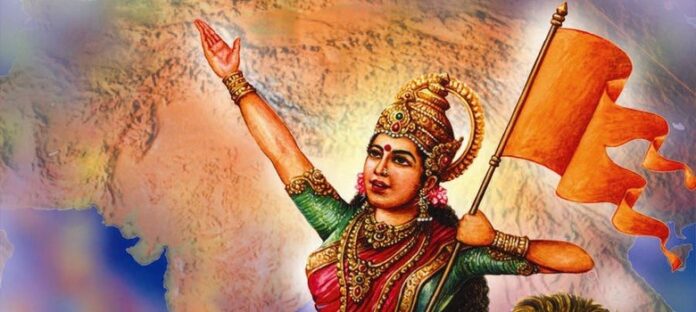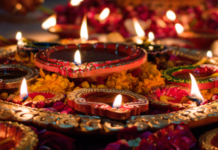Bharat Mata is an idea, a symbol, an image, that reflects the construction of femininity and patriotism through numerous frameworks of political and social ideologies. The three pictorial representations of Bharat Mata/ Mother India, depend on a series of codes and signs to depict the notion of a specific form of nationalism. The pictures seem to represent a woman as the symbol for the larger concept of nationalist feeling and vigour. In the current Indian political context, this construction of idolization around femininity is a tool for creating a discourse of passivity and silence in relation to women.
Historically, as these representations prove, there has been an association of women and the nation-state in order to invoke patriotism. The idea of Bharat Mata or ‘Mother India’, is a popular trope used in contemporary and historical discourse to promote a passive, angelic role of women in Indian society. It is an intensely problematic ideal that uses the idolization of women to perpetuate a gendered division between the public and private realm as women as goddesses are relegated to the domestic space because of their inherent ‘virtue’.
In the present context, these three pictorial representations are not merely images. They are heavily attributed with cultural meaning garnered through a historical context of iconography and patriarchy. The use of signs and codes is integral to the process of cultural conditioning, which is done through the idea of Bharat Mata or Mother India. In order to gain a semiotic understanding of the representations, it is essential to look at Ferdinand De Saussure’s theory of signs. A.A. Berger in “The Science of Signs” from The Object of Affections (2010)lays down the theory of semiotics as proposed by Saussure.
According to Saussure, all signs are oppositional and relational. An image or a representation only obtains meaning when it is seen in relation to something else. He proposed ‘Langue’ or language as a system of signs which is comprised of the signifier and the signified. The signifier is a mental concept which is signified by an acoustic image. It is a system composed of arbitrary relationships without any terms, things, or speaking subjects. In the given pictorial representations, there are no specific relationships between patriarchy, nation, or pride with the women represented but through a codified system, these images are naturalised as representing the nation and a specific ideology.

Thus, the woman’s body becomes a symbol in relation to the signifier of nation-state. The relationship between a woman as the mother and the nation is thus, completely based on conventions arising out of a turbulent political history. As this symbol was popularised through the use of media and visuals, it became naturalised in the society and led to reproduction and strengthening of problematic ideals of nationality as it became intertwined with religion.
All forms of entertainment contain a subtext of prejudices based on class, caste, race, gender, among various other social categories. As they are reified and constructed as the “normal”, they are imbibed with social meaning leading to integration with political meaning. Thus, cultural representations can and are used by dominating and powerful institutions to control the narrative and reproduce dominant discourses and social institutions. While images may seem innocent, they often carry a hidden agenda which is derived from the larger socio-political context.
In the poster of the film ‘Mother India’, the image is passionate and emotive which centres around the symbol of the mother as the cultural bearer and embodiment of national territory. Mother India was released in 1957 when there was a strong nationalist fervour in the country. Nehru’s rule brought in a discourse of modernity and technology. But this discourse was centred around the idea of the woman as an iconic re-imagination of the nation. In the figure of the woman, the process of cultural hegemony began as she was to be the symbol of culture and tradition of Indian society in a nation that was rapidly changing.
As there was an internal political struggle at play after independence, it was essential to come up with a symbol to provide reassurance and portray the promise of stability. It was necessary to create a post-colonial identity and this was emphasized through the woman’s body. Thus, the emphasis came to be on the body politic as opposed to the body natural. While the idea of ‘body politic’ is borrowed from monarchic power and representation of the Queen as England, it is extremely relevant to the idea of Bharat Mata as a woman is represented as the entire consciousness of India as a nation.
The image of Mother India was used by the Nationalist movement to represent the ‘new’ woman and her position in the modern era of the nation. Thus the connotation became the promise of a modern India which is progressing while keeping its traditions alive. As culture was imposed upon a woman’s body, the woman became the site of a new emerging discourse which rested on borrowing colonial heritage of euro-centric discourses while preserving tradition and socio-cultural values of India.
The burden of tradition fell on the woman who was slowly integrated into the nationalistic agenda based on Brahmanical values of domesticity and docility for women. There was a static place of the women within the family structure as her reproduction function was emphasised. This also linked the woman to nature through the framework of fertility. Thus, the representation of women and their bodies transmitted a certain image which was inherently patriarchal. By reimagining the woman as the pure form of the nation, there is an assumption that the woman is the loving ‘mother’, dutiful and loyal to the nation and its protector.
These ideas were perpetrated through popular re-imaginations like the film ‘Mother India’ and other forms of art and media productions which led to a normalising discourse and creation of a myth of the benevolent woman. Thus, the body politic was foregrounded in order to curtail the ‘body natural’ which was associated with sexuality and transgression.

While in 1957, these notions were emerging, the concretisation is seen in present representations. The inclusion of religion into the political idea of Bharat Mata, brought in the concept of mother goddesses. The RSS poster of Bharat Mata the nation in the figure of the woman by superimposing the image of a mother goddess on the geographical image of India. Through this process, it is a clear indication that the woman as a mother and a goddess is the nation and needs protection. She is also holding a saffron flag which is the colour associated with RSS, an intensely right-wing political group.
The increasing ‘saffronisation’ or the spreading of a brand of Hindutva Nationalism is based on specific ideologies that aim at continued subjugation along the lines of religion, class, caste, and gender.The representation of the mother goddess inscribed on the national geographical representation is used to entrench the body of the woman as the symbol for the mythic mother of the nation. The symbol of a mother is privileged in a unique way in a patriarchal society as she is the upholder of culture, tradition, life-giver and self-sacrificing. Thus, the woman’s body becomes a political space and not something that exists on its own.
In the present context, the idea of Hindutva is prevalent and there are attempts to naturalise it. Certain groups aim at promoting a class, gender, and religion specific agenda. The image of ‘Bharat Mata’ clearly reflects that agenda as the woman in the image is benevolent, smiling, representative of certain “dominant or preferred meanings” as Hall (1980) postulated(p. 134)
Roland Barthes (2001) posited that myth is a form of speech which is not completed at the level of denotation. As mentioned, Saussure looked at signs as comprising of the signifier and the signified, however, myths introduce a second-order semiological system. Myth is a sign that uses another sign as a signifier. Thus, the myth of the Mother Goddess/ Mother India is in itself a sign, connoting the larger pervasive structural ideologies. It is a perpetuation of bourgeoisie and its conceptions of women.
This is used to normalise certain perspectives and make them comply to the dominant ideal. The influence of this class-based perspective is clearly seen in the RSS representation of mother goddess. She is a clear representative of a certain group i.e. the bourgeoisie. Even though she is a goddess and theoretically above the distinctions of class, she represents the bourgeoisie ideal of divinity. This argument is supported by the use of excessive jewellery in the representation.
The myth becomes a cultural dialogue and as the “function of myth is to empty reality” (Barthes, 2001, p.143) and make a shift from history to nature, it distorts signs and language. The myth rose in a time of conflict because of colonialism and consolidated itself through language and posited ‘woman’ as the mother of the nation-state. There is a creation of a utopic ideal of a politicised body based on Hinduism, naturally excluding any diverging viewpoints.
This myth of a religious Bharat Matawith the connotation of spreading Hindutva is reversed by M.F. Hussain in his depiction of Bharat Mata as he uses the same technique but the consequence of connotation is different.The painting by M.F. Hussain provides a fresh perspective on the image of the Mother India. It deviates from the traditional benevolent representation of the woman. While in the traditional representations, like the RSS poster, the Goddess is adorned with excessive jewellry and she is leaning on a lion, Hussain chose to anthropomorphize the nation as well but in stark contrast as the figure is nude.
She is not adorned with jewellry or even clothes, she is painted nude in a raw manner. This image can be interpreted through a different framework of the nationalist discourse and its use of a woman as a symbol. The use of the colour red throughout the body of the woman and India can be seen as representing the violence on a woman’s body and the nation.
Women are faced with various forms of violence every day and the despondent expression of the represented woman present the context of violence upon the woman’s body. This also is a revelation of the reality of society and how in spite of the symbol of Bharat Mata, a woman is still vulnerable and endangered to new forms of violence in a patriarchal society.
.jpg)
The idea of the ‘body politic’ and ‘body natural’ can also be seen in Hussain’s representation of Bharat Mata as he depicts the body politic along with the body natural by painting the nude body of a woman as the nation. This allows her sexuality to be displayed but not for the gaze of the spectator. She is nude in order to be a woman, not for the perception of any spectator.
It is the natural state which is politicized through the stretching of her body into the shape of India. The three images thus provide separate perspectives and reveal backgrounds that have shaped their production. The final production accompanies the ideas of Bharat Mata as a dominant symbol of patriotism and nationalism but this symbol acquires meaning only through differences.
Stuart Hall’s model of encoding-decoding is useful in understanding the meaning of Bharat Mata as a “terrain of struggle”(Hall, 1980). Hall’s model is based on the forming a new model of communication which posits the spectator as an active agent. He charts out the processes of encoding and decoding as production and consumption respectively, structured through frameworks of knowledge, relations of production, and technological infrastructure which organised the knowledge and its representation into meaningful discourse.
An important point made by Hall is that the process of production itself is affected by discourse and framed trough meanings and ideas emerging from socio-cultural and political contexts. Hall (1980) describes every level of communication as “linked but distinctive moments” (p. 128) and there is a “lack of fit” (p. 131) between the moment of production or encoding and the moment of reception or decoding.
This space between encoding and decoding is where the meaning of the text resides and it is a “terrain of struggle” because it is interpreted through various frameworks provided by various social situations and as the connotation is influenced by ideologies, it becomes an area of contestation. Hall also talks about how on the side of encoding, there is are certain preferred meanings which are embedded within any media text as a result of the pervasion of specific cultural codes which have been naturalized.
Therefore, if the representation of Bharat Mata is looked at through Hall’s model, the image presents a possibility for varying interpretations. This decoding is based on different social locations and economic backgrounds of the spectators. For instance, a person who has grown up within a feminist household where problematic notions have been exposed would have an opposing reading of the image of Bharat Mata as a whole concept because they would be able to recognise the connotation of patriarchy and its relation to a certain construction of femininity.
But at the same time, a person belonging to a certain group with Hindutva ideologies may interpret Bharat Mata as a powerful symbol of the caretaker of the nation. Even within different social locations, there are different perspectives as they are not homogenous. A person who identifies as a feminist may choose to look at the aspect of empowerment by the established presence of a woman in mass media.
Consequently, the image of Bharat Mata is a “terrain of struggle” as it is constantly negotiated and interpreted differently by individuals and groups belonging to different locations, emerging from different socio-cultural contexts. This idea may be explained clearly with the introduction of a different perspective.

In a conversation with an individual from Germany who identifies as a woman and belongs to a middle-class family and has a psychology educational background, the idea of meaning as a struggle” was clarified. Her perception of the first image of the poster of ‘Mother India’ was that it is extremely dramatic and the woman looks pained. In her own words “due to her cultural location” she was reminded of Jesus’ crucifixion due to her agonized expression and her positioning.
It also reminded her of an apocalyptic scene of panic and the colours, for her, amplify the drama in the picture. An immediate connection was made between the idea of ‘Mother India’ as the protector of the nation but the protector herself is exposed. An emotion of worrying was also associated by her in this context as she was moved to protect the woman in the poster. The second representation brought out a completely different understanding. There was a focus on the background for her which was “natural” and she related it to the connection between femininity and nature.
The use of natural imagery provided a calming atmosphere for her which was expounded on by the smiling figure of the woman. Interestingly, the flag was a symbol of power in her view and even her hand which was upheld reflected a certain spiritual power for her. It is interesting because this connection of spiritual power and an association with the “western goddesses” was made due to the presence of the holy circle around her head. Even the lion was seen as a silent but powerful companion of the woman.
The last image was striking for her due to the bold use of red color. She immediately recognized the depiction of the woman as India due to the names of the cities. This image for her was again a positive representation due to the use of bright colors. The wheel and the silhouette in the background were disturbances for her. She interpreted the silhouette as a man due to the seeming appearance of broad shoulders and wider body frame and he seemed to be watching over the woman.
The wheel seemed out of context for her as she recognized it as part of the Indian flag but confused about why it was in the painting. Overall, the three images for her provided different perspectives on the idea of a woman as a mother as the first one made the woman seem more accessible and as someone who needs protection as she is threatened by the society, while the other two pictures represented positive interpretations as there was space for understanding them through alternative frameworks.
In comparison, her understanding or reading of the images is vastly different from mine as we both come from different cultural and social location. Due to my upbringing within the Indian culture, the images were associated larger understandings of religion and its influence as well as certain class and caste power relations that are underlying in the representations. By looking at the images from a western perspective, a different perspective of religion creeps in as it is looked at from Christian mythology and history.
There is also an acceptance of the dominant ideology, probably not in the sense of a promotion of Hindutva but there is no challenge from her towards the representation of a woman as mother or goddess as her interpretation is devoid of Indian context that lends a significant meaning to the image of Bharat Mata. These associations and meanings are reified through constant reproduction and consolidated into the cultural memory of society; they are naturalized.

But as communication is a circuit of reciprocation and negotiation according to Hall, the arena of reception also provides space for consent and resistance. Culture in itself is a space of struggle immanent with the possibility of interpretation; this is reflected in the production ‘moment’ as well as the ‘moment’ of reproduction of dominant discourses. In the conversation, ideas emerged from a Western perspective which contrasted with the Indian perspective reflecting the struggle of interpretation.
In conclusion, the image of Bharat Mata is a concretised myth and at the same time a sign for a burgeoning nationalist discourse which promotes a passive status of women and religious connotation of the ‘ideal’ citizen. This analysis also reveals the hypocrisy of using the image of the Bharat Mata as a figure who is revered and protected but in reality, the status of women remains oppressed as they are faced with violence in all forms, every day.
The image of Bharat Mata is therefore, not a harmless representation; it clearly is encoded with dominant ideologies of patriarchy, bourgeoisie, and religious discourses. The three images reflect how these ideologies work in their socio-cultural context and allow for varying interpretations.

















































